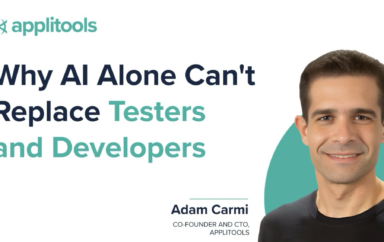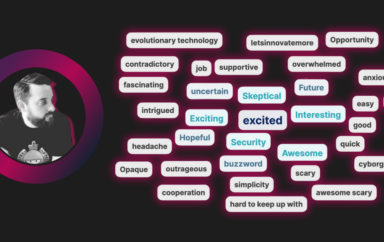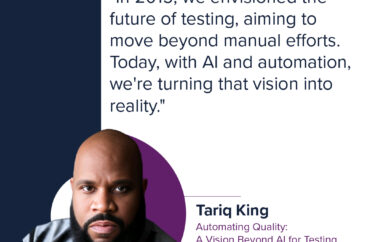A few weeks ago, Applitools hosted a conference on the future of testing for mobile applications. Almost 4000 people registered for the event, creating a fun and exciting atmosphere in the chat for each session as well as for the live Q&A that followed. There was a lot to learn and it was a great opportunity to engage with the testing community on such an important topic.
The videos are all available now in our on-demand library and can be watched for free. If you want to dive right in and watch them right now and skip this recap, go ahead, I won’t blame you ?. You can check them all out at the link below.
The Path to Autonomous Testing – Gil Sever
The opening remarks were from Applitools CEO and co-founder Gil Sever. In this ten-minute presentation, Gil delivers a strong primer on what autonomous testing really is – and how machine learning can help assist humans and make testing much, much more effective. Tune in for a glimpse at the autonomous future.
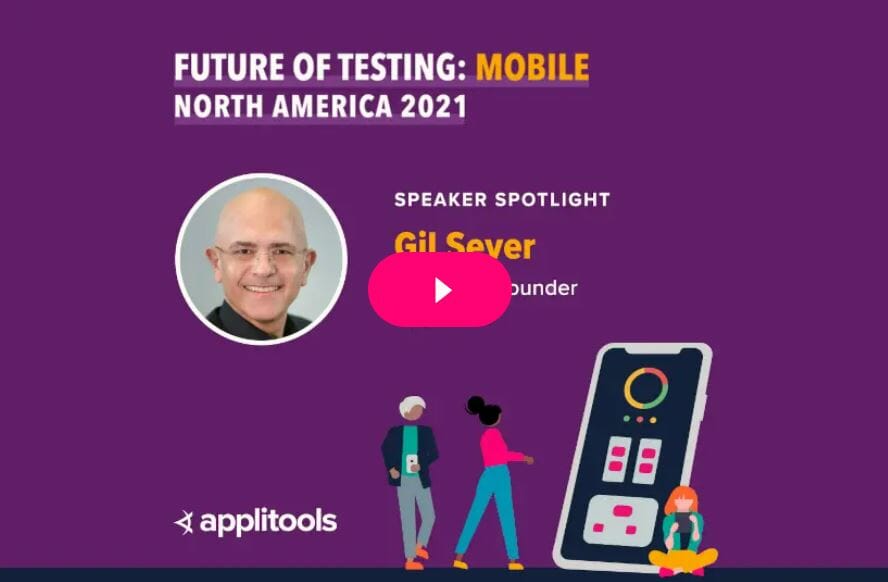
On the Same Wavelength: Adding Radio to Your Testing Toolbox – Jason Huggins
Jason Huggins was the opening keynote speaker at the event, and he gave a fascinating talk on where testing is headed. As Jason says, “testing is getting weird,” and is increasingly about things you can’t even see. He argues that it’s time to move past an understanding of testing as just simulating what can be seen and tapped. What mobile testers are ultimately interested in today is the triggering of radio activity. That’s the essence of how your app truly performs, isn’t it?
Jason is a founder of Selenium, Appium, and Tapster Robotics, so he knows quite a bit about where testing has been and where it’s going. Check out his talk to hear what he has to say.
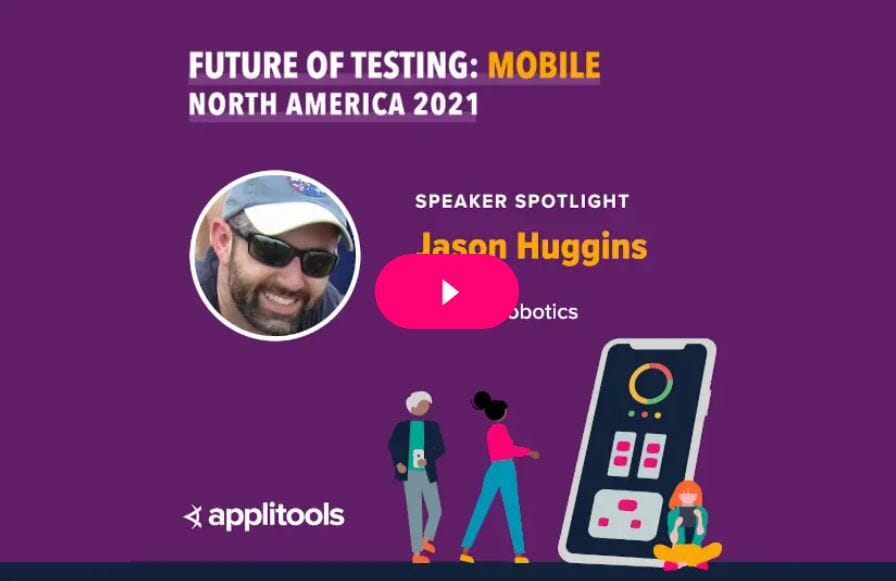
Appium 2.0: What’s Next – Sai Krishna, Srinivasan Sekar
Appium is a very popular test automation framework, and the upcoming release of Appium 2.0 is highly anticipated. Sai and Srinivasan are both contributors to the Appium project as well as lead consultants at ThoughtWorks, and in their presentation you’ll find a preview of what’s coming with Appium 2.0.
For example, today you need to install a large number of drivers when you install Appium server – even ones you don’t need. With Appium 2.0, you can just install the ones you need. Another example has to do with bug fixes – a lot of fixes are added to betas but many people don’t install betas and miss out, so with Appium 2.0 the fixes will be attached to individual drivers and rolled out faster. There will be improved docs and it’ll be easier to build your own plugins… the list goes on.
Catch Sai and Srini’s presentation to learn all about it. And if you’re ready to try it out for yourself, read our blog post on Getting Started with Appium 2.0 Beta.
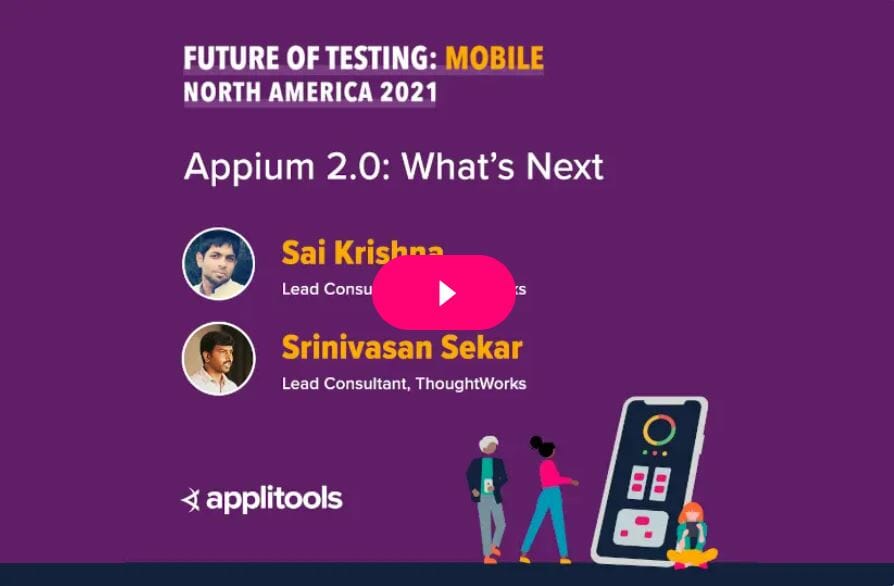
Coffee Break
You might think there’s not much to recap during a coffee break, but during the first coffee break of the conference the brand-new Test Automation Cookbook was introduced to the world. This is a collection of bite-sized recipes you can use to answer a number of specific and common questions you may have about test automation. This “commercial break” was very well received by the audience ?.
Mobile App Testing & Release Strategy – Anand Bagmar
Your mindset needs to be mobile-first. That’s how Anand, a Quality Evangelist and Solution Architect at Applitools, opened his talk. He followed that up with an overview of the differences between web and mobile testing/releasing, including mobile test automation on a local/cloud device lab. Anand explains that even after all our hard work in continuous testing, sometimes visual tests can still come down to a game of manual “spot the difference.”
Visual AI is a difference-maker there, as Anand explains. He talks about the difference between Visual AI and pixel comparisons and how you can apply it yourselves. Take a look at this talk for a great overview of mobile testing and releasing.
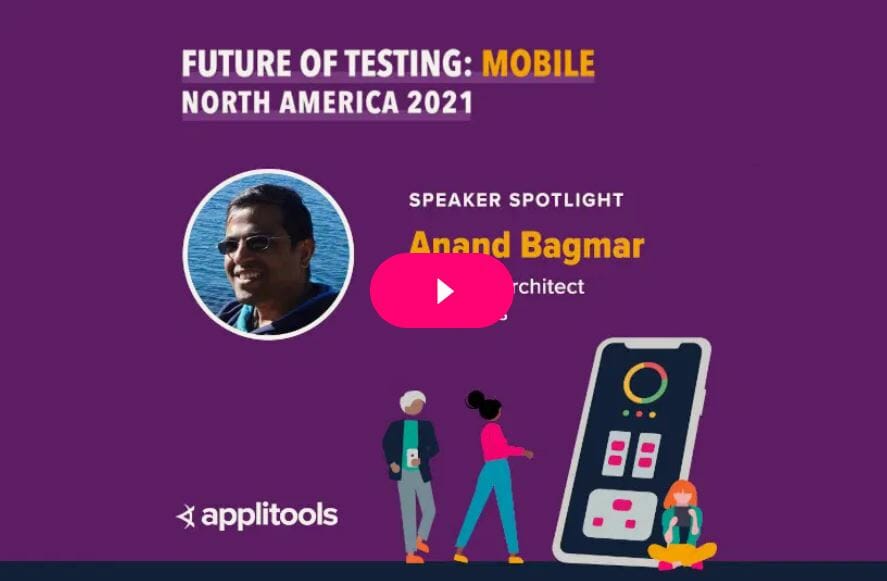
Next Generation Mobile Testing with Visual AI – Adam Carmi
Adam Carmi, a co-founder and CTO of Applitools, picked up with Anand left off with a deeper dive into Visual AI. Adam walks through a live demo of Applitools Eyes so you can see it for yourself. He talks about the huge code reduction when you use Eyes – up to 80% – which also gives you increased coverage and no validation logic to maintain. He backs this up with hard data from a hackathon, highlighting the fact that many testers were completely new to Applitools and were able to pick it up quickly and get some really strong results.
Adam’s talk was full of examples of how Eyes can work in the kinds of scenarios you may be wondering about, including how Eyes deals with different mobile form factors and how it batches together similar errors that can be approved/rejected together. Check it out.

Expert Panel: State of the Mobile Frameworks
This panel gathered together three mobile development experts for a robust discussion of what life is like for developers using different mobile frameworks. Eran Kinsbruner, DevOps Chief Evangelist and Sr. Director, Product Marketing at Perforce Software, Eugene Berezin, iOS Developer at Nordstrom and Moataz Nabil, Mobile Developer Advocate at Bitrise shared a lot of great information about the frameworks they use, which included Flutter, Appium, Kif, EarlGray and of course XCUITest and Espresso.
The panel was moderated by Justin Ison, Sr. Software Engineer at Applitools. Justin led the panel through a conversation around framework limitations, how to make apps testable, and what could make mobile testing easier. You can check out the whole discussion below. And if you’re curious for a quick comparison, be sure to take a look at a recent writeup on our blog that tackles Appium vs Espresso vs XCUITest

The Future of Multi-Platform Integration Testing – Bijoya Chatterjee, Rajnikant Ambalpady
Bijoya and Rajnikant work on testing for the new SONY PlayStation 5, giving them a unique outlook on what it takes to deliver strong integration testing across platforms. In this talk, they describe the challenge of having many standalone apps that require automated testing, when there aren’t any off-the-shelf tools that are built to test a PlayStation! They ended up customizing Appium and making use of many other tools in their stack (this might be a good place to mention that Applitools is part of it, which I did not know until I heard Bijoya tell the audience ?).
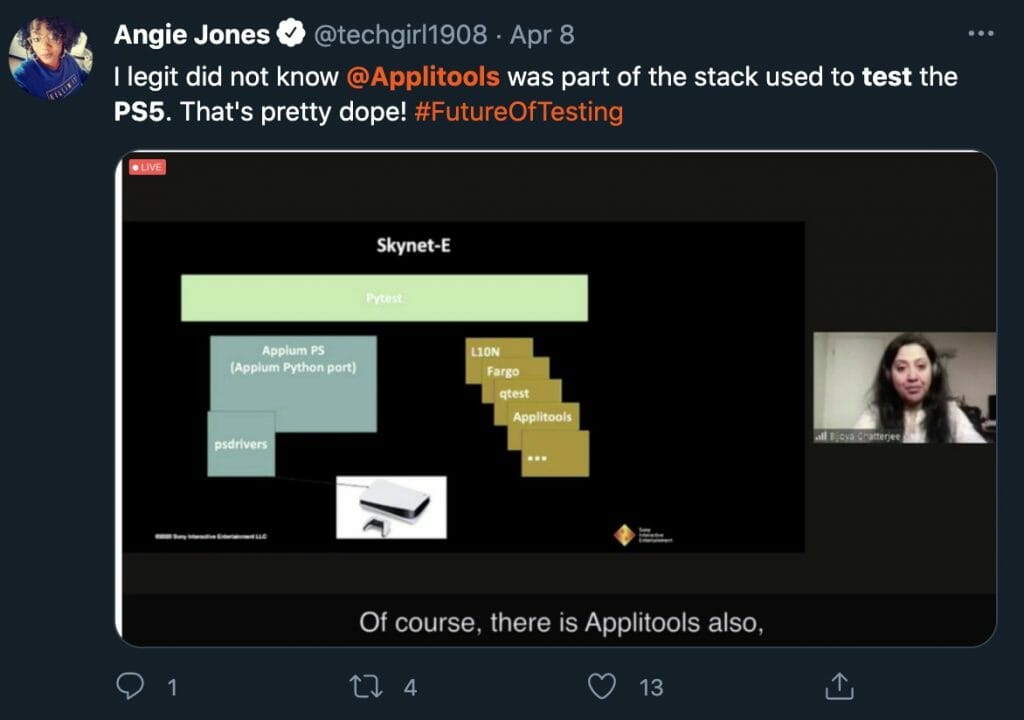
They cover the challenges of testing numerous standalone components within apps that must talk to each other, as well as testing across platforms from console to web to mobile. For a discussion of the pros and cons of end-to-end integration testing and much more, be sure to check out this talk.
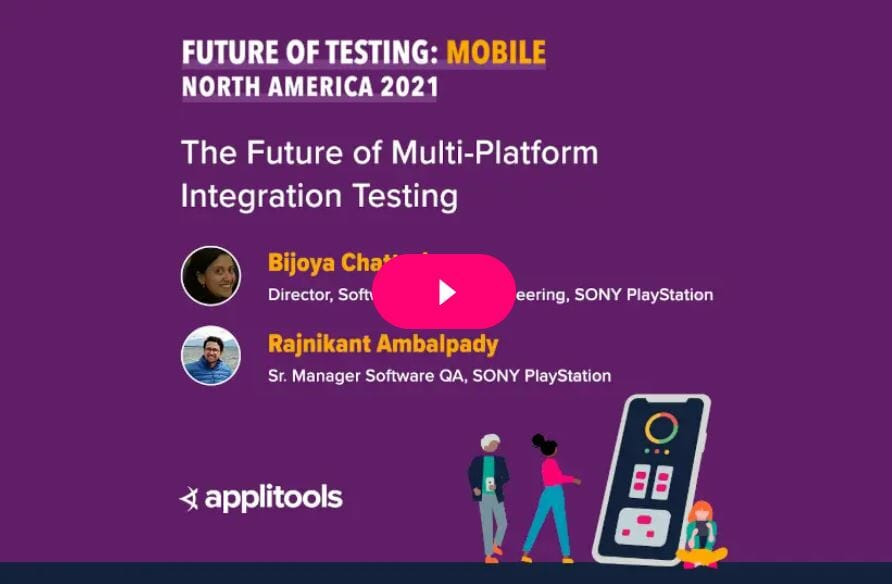
Let the Robots Test Your Flutter App – Paulina Grigonis, Jorge Coca
It’s not easy to organize code so that it’s A) maintainable and customizable by development teams, and B) still easily understood and readable by business stakeholders. In this presentation, Paulina and Jorge, who are respectively business and technical experts at Very Good Ventures, walk us through a methodology they call the Robot Pattern. This pattern separates the “What” from the “How” of testing and can result in some pretty spiffy code. Definitely very easy to read even for a non-technical user.
Want to learn how to implement this pattern in your own development? Check out their presentation below.
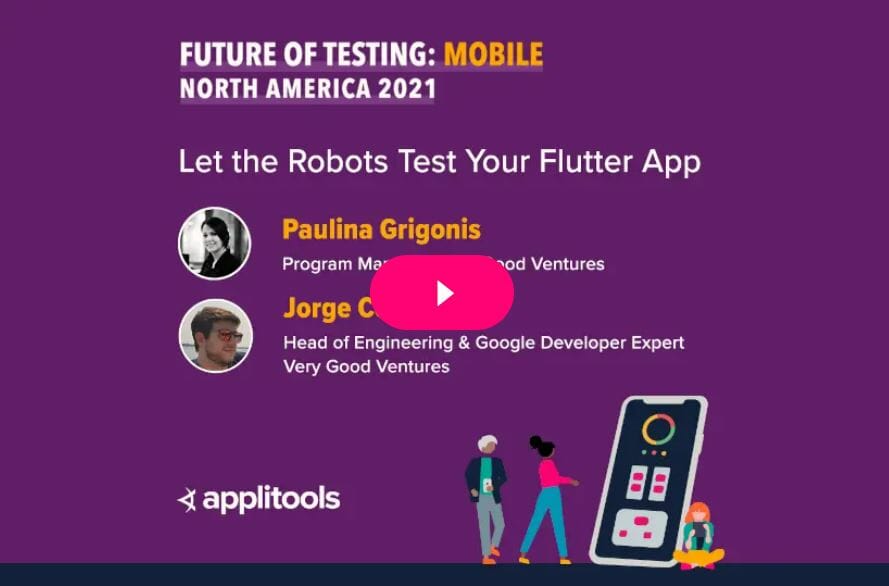
Your Tests Lack Vision: Adding Eyes to Your Mobile Tests – Angie Jones
As humans, we can only pay attention to so much at one time – and that means we miss things, even in plain sight. The closing keynote from Angie Jones makes this clear from the first moments with a great video clip. I won’t spoil it, but it reminded me a lot of another video when I saw it, so after you watch Angie’s talk go ahead and take a look at this one too and see how it goes if you want to laugh at yourself.
After helping us all understand our blind spots, Angie provides a lot of great examples of how visual bugs slip through traditional testing processes. She then walks us through a demo of a new app and show us how Applitools Eyes can help us make sure it’s visually perfect. In the live Q&A, Angie also answers a number of questions around handling multiple viewport sizes or when you have to scroll, and even testing variations like light and dark mode or dealing with pop-up notifications and alerts.
Angie also shared her inspiration behind launching the automation cookbook (hint: it’s making the life of fellow testers easier). If you haven’t taken a look at it yet, be sure to check out the automation cookbook here.
You can see Angie’s full talk below.

Thank You!
And with that (and a few closing remarks from host Joe Colantonio of TestGuild) the Future of Testing Mobile event ended. We want to extend a huge thanks to everyone involved in making this event such a success, from Joe for his incredible hosting to the amazing speakers for sharing their insights to every attendee for adding your voices and presence. The event could not happen without all of you.
If you liked these videos, you might also like our videos from our previous Future of Testing events too – all free to watch. Happy testing!


